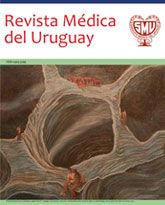Intoxicación grave por bloqueadores de los canales de calcio
Resumen
La intoxicación por bloqueadores de los canales de calcio puede dar lugar a un cuadro extremadamente grave. Presentamos el caso de un paciente con intoxicación severa por diltiazem que desarrolló un profundo estado de shock y disfunción multiorgánica. La inestabilidad hemodinámica puede ser refractaria a las medidas terapéuticas habituales, requiriendo la implementación de tratamientos coadyuvantes para sostener las funciones vitales. Analizamos la presentación clínica y fisiopatología de la intoxicación por calcio antagonistas. Finalmente, presentamos las alternativas terapéuticas en base a la evidencia actual.
Citas
(2) Salhanick SD, Shannon MW. Management of calcium channel antagonist overdose. Drug Saf 2003; 26(2):65-79.
(3) Shah SK, Goswami SK, Babu RV, Sharma G, Duarte AG. Management of calcium channel antagonist overdose with hyperinsulinemia-euglycemia therapy: case series and review of the literature. Case Rep Crit Care 2012; 2012: 927040 doi: 10.1155/2012/927040. Disponible en: http://www.hindawi.com/crim/cc/2012/927040/cta/. Consulta: 5 mayo 2012.
(4) Lheureux PE, Zahir S, Gris M, Derrey AS, Penaloza A. Bench-to-bedside review: hyperinsulinaemia/euglycaemia therapy in the management of overdose of calcium-channel blockers. Crit Care 2006; 10(3):212-7.
(5) Newton CR, Delgado JH, Gomez HF. Calcium and beta receptor antagonist overdose: a review and update of pharmacological principles and management. Semin Respir Crit Care Med 2002; 23(1):19-25.
(6) Satchithananda DK, Stone DL, Chauhan A, Ritchie AJ. Lesson of the week: unrecognised accidental overdose with diltiazem. BMJ 2000; 321(7254):160-1.
(7) Min L, Deshpande K. Diltiazem overdose haemodynamic response to hyperinsulinaemia-euglycaemia therapy: a case report. Crit Care Resus 2004; 6(1):28-30.
(8) Comellas AP, Kelly AM, Trejo HE, Briva A, Lee J, Sznajder JI, et al. Insulin regulates alveolar epithelial function by inducing Na+/K+-ATPase translocation to the plasma membrane in a process mediated by the action of Akt. J Cell Sci 2010; 123(Pt 8):1343-51.
(9) Humbert VH Jr, Munn NJ, Hawkins RF. Noncardiogenic pulmonary edema complicating massive diltiazem overdose. Chest 1991; 99(1):258-9.
(10) Roper TA, Sykes R, Gray C. Fatal diltiazem overdose: report of four cases and review of the literature. Postgrad Med J 1993; 69(812):474-6.
(11) de Pont AC. Extracorporeal treatment of intoxications. Curr Opin Crit Care 2007; 13(6):668-73.
(12) Morales MG, Guerrero SG, García GR, Villalobos SJ, Camarena AG, Aguirre SJ, et al. Intoxicación grave con verapamilo. Arch Cardiol Mex. 2005; 75 (Suppl 3):S3-5.
(13) Harris NS. Case records of the Massachusetts General Hospital: case 24-2006. A 40-year-old woman with hypotension after an overdose of amlodipine. N Engl J Med 2006; 355(6):602-11.
(14) Engebretsen KM, Kaczmarek KM, Morgan J, Holger JS. High-dose insulin therapy in beta-blocker and calcium channel-blocker poisoning. Clin Toxicol (Phila) 2011; 49(4):277-83.
(15) Kline JA, Raymond RM, Leonova ED, Williams TC, Watts JA. Insulin improves heart function and metabolism during non-ischemic cardiogenic shock in awake canines. Cardiovasc Res 1997; 34(2):289-98.
(16) Boyer EW, Shannon M. Treatment of calcium-channel-blocker intoxication with insulin infusion. N Engl J Med 2001; 344(22):1721-2.
(17) Greene SL, Gawarammana I, Wood DM, Jones AL, Dargan PI. Relative safety of hyperinsulinaemia/euglycaemia therapy in the management of calcium channel blocker overdose: a prospective observational study. Intensive Care Med 2007; 33(11):2019-24.
(18) Varpula T, Rapola J, Sallisalmi M, Kurola J. Treatment of serious calcium channel blocker overdose with levosimendan, a calcium sensitizer. Anesth Analg 2009; 108(3):790-2.
(19) Osthoff M, Bernsmeier C, Marsch SC, Hunziker PR. Levosimendan as treatment option in severe verapamil intoxication: a case report and review of the literature. Case Report Med 2010; 2010. pii: 546904. Disponible en: http://www.ncbi.nlm.nih.gov/pmc/articles/PMC2931406/pdf/CRM2010-546904.pdf. Consulta: 10 marzo 2012.














